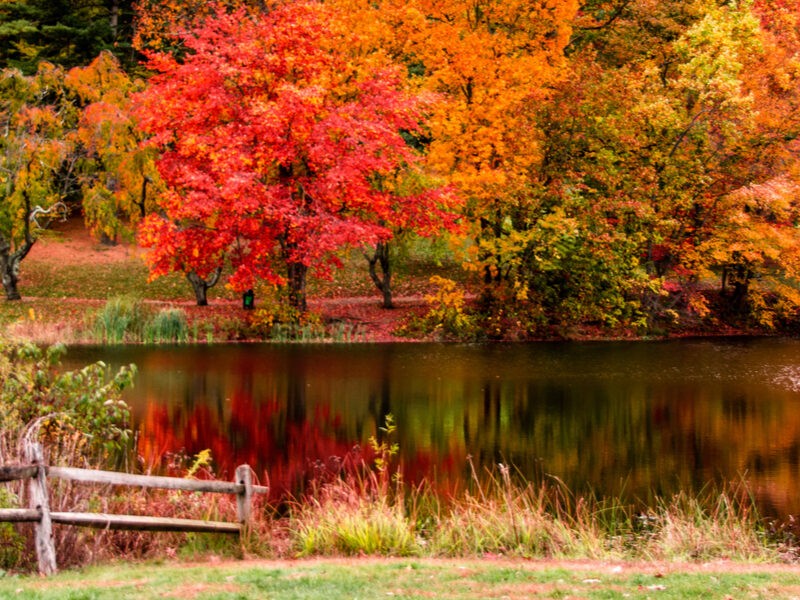Here’s Why Trees Change Their Colors And Lose Leaves In Autumn
October might be the best time to be a Michigander. Football season is in full swing, the temperatures are cool enough for sweaters, and autumn leaf color is absolutely splendid. Maybe you’ve been lucky enough to visit Michigan’s Tunnel of Trees to see for yourself. Have you ever wondered why trees turn those vibrant shades of red, orange, and yellow? That’s the question we’ll answer in today’s blog.
Why Trees Turn Color In The Fall
During the normal growing season, trees absorb compounds called carotenoids – yes, this is also what gives carrots their orange color. During spring and summer, the green chlorophyll, which plants use for photosynthesis, is actively working to capture sunlight and turn it into food for the trees. As such, the greenness of the chlorophyll covers the carotenoids. However, they will no longer be dominant in the fall.
When the temperature begins to lower in fall, the chlorophyll breaks down and degrades, going from green to completely colorless. When this happens, the oranges and yellows can take their place, and voila! Fall colors!
What About Red Leaves?
In fall, the most notable examples of red-leaved trees are red maples, sugar maples, black gums, dogwoods, sourwoods, and oaks. Unlike orange and yellow pigments, red is not present during summer. When trees have red leaves in autumn, it’s because they have started producing a pigment called “anthocyanin.” For us humans, who can appreciate beautiful colors, this looks gorgeous. Trees don’t have a concept of beauty, however. Instead, they need this pigment to prepare themselves for the long road to winter.
Believe it or not, anthocyanin is a tree’s version of sunscreen. It helps protect them from the bright autumn sun when it’s colder outside. When trees receive too much light, it can interfere with nutrient transport from the leaves to the branches. Some scientists also suspect that the red color is meant to discourage insects from sheltering on the tree. When trees are vibrant red and therefore have ample anthocyanin, bugs may seek out trees that aren’t as healthy. That’s why proper tree care is so important. The healthier the tree, the less likely it is to fall prey to insects and diseases.
Conditions That Affect Michigan’s Fall Colors
The years when we experience the best fall colors Michigan offers are when days are sunny and nights are steadily getting colder. This gradual cooling signals the trees to start producing sugars, which tells the leaves to make anthocyanin.
If there’s a great deal of cloud cover, rain, or heath lingering in late summer and early fall, it could produce less exciting, duller colors. Conversely, you don’t want the frost to come too early. Just as a pilot needs to steadily lower a plane to land, so too does the temperature need to drop at a gentle rate for trees to get that brilliant color.
Why Do Some Trees Lose Their Leaves
Evergreens aren’t called that for nothing. Also known as conifers, they will keep their greenery year-round. Trees that aren’t conifers fall into the other category: deciduous. This covers all trees that lose their greenery in autumn, remain bare through winter, and sprout new greenery in spring. The short answer has to do with the availability of water. When there isn’t enough moisture, leaves can’t function properly. To conserve its resources, the tree will shed its leaves. Technically, evergreen needles are leaves, and they do shed them. If you’ve got an evergreen tree in your yard, you no doubt have noticed that needles are often so thick beneath it that nothing can grow. However, evergreens are not classified as deciduous because their leaf shedding is not tied to a specific season. Rather, their needles are like hairs on the human head. If you brush your hair every day, you might lose a few strands, but your hair does not fall out every fall and regrow in the spring.
Keep Your Trees Healthy Year-round With PPM Tree Service & Arbor Care
Whether you’ve already got plenty of fall foliage or would like to add some to your yard, the professionals at PPM Tree Service & Arbor Care are here to help. From planting saplings to pruning mature trees, we will ensure your yard is bursting with colorful, healthy trees every fall for years to come. To learn more about our services, give us a call at (877) 454-8733, or you can reach us through our online form.
We hope you enjoyed this blog, and if so, you can read other blog articles on our blog page. And don’t forget to like us on Facebook, follow us on Twitter, or check out our Pinterest boards.


